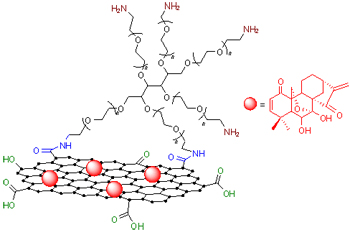| [1] (a) Zhou, W. S.; Cheng, Y. X. Acta Chim. Sinica 1990, 48, 1185 (in Chinese).(周维善, 程云行, 化学学报, 1990, 48, 1185.)(b)Wang, J.; Hou, H. M.; Xia, Y. R.; Sun, H. D.; Pu, J. X. Chin. J. Pharm. 2012, 43, 194 (in Chinese).(王健, 侯惠民, 夏怡然, 孙汉董, 普建新, 中国医药工业杂志, 2012, 43, 194.) [2] Xia, Y. R.; Wang, J.; Zhu, J. P.; Li, D. Chin. J. Pharm. 2010, 41, 41 (in Chinese). (夏怡然, 王健, 朱金屏, 陈芳, 李丁, 中国医药工业杂志, 2010, 41, 41.) [3] Zhao, Y.; Niu, X. M.; Qian, L. P.; Liu, Z. Y.; Zhao, Q. S.; Sun, H. D. Eur. J. Med. Chem. 2007, 42, 494 [4] (a) Ojima, I.; Geng, X. D.; Wu, X. Y., Qu, C. X.; Borella, C. P.; Xie, H. S.; Wilhelm, S. D.; Leece, B. A.; Bartle, L. M.; Goldmacher, V. S.; Chari, R. V. J. J. Med. Chem. 2002, 45, 5620. (b) Zhao, C. W.; Zhuang, X. L.; He, P.; Xiao, C. S.; He, C. L.; Sun, J. R.; Chen, X. S.; Jing, X. B. Polymer 2009, 50, 4308. [5] (a) Liu, Z.; Chen, K.; Davis, C.; Sherlock, S.; Cao, Q. Z.; Chen, X. Y.; Dai, H. J. Cancer Res. 2008, 68, 6625. (b) Huang, X. W.; Guo, L. N.; Lu, G. L.; Huang, X.; Zhang, Y. Q.; Huang, X. Y. Acta Chim. Sinica 2009, 67, 1363 (in Chinese).(黄晓炜, 顾丽娜, 陆国林, 黄啸, 张亚琴, 黄晓宇, 化学学报, 2009, 67, 1363.) (c) Chen, S. Y.; Zhao, X. R.; Chen, J. Y.; Chen, J.; Kuznetsova, L.; Wong, S. S.; Ojima, I. Bioconjugate Chem. 2010, 21, 979. [6] Sun, X. M.; Liu, Z.; Welsher, K.; Robinson, J. T.; Goodwin, A.; Zaric, S.; Dai, H. Nano Res. 2008, 1, 203. [7] (a) Novoselov, K. S.; Geim, A. K.; Morozov, S. V.; Jiang, D.; Zhang, Y.; Dubonos, S. V.; Grigorieva, I. V.; Firsov, A. A. Science 2004, 306, 666. (b) Dai, J.; Lang, M. D. Acta Chim. Sinica 2012, 70, 1237 (in Chinese). (戴静, 郎美东, 化学学报, 2012, 70, 1237.) (c) Deng, Y.; Li, Y. J.; Dai, J.; Lang, M. D.; Huang, X. Y. J. Polym. Sci., Part A: Polym. Chem. 2011, 49, 1582. (d) Wang, B.; Yang, D.; Zhang, J. Z.; Xi, C.; Hu, J. J. Phys. Chem. C 2011, 115, 24636. [8] (a) He, H. Y.; Klinowski, J.; Forster, M.; Lerf, A. Chem. Phys. Lett. 1998, 287, 53. (b) Deng, Y.; Li, Y. J.; Dai, J.; Lang, M. D.; Huang, X. Y. J. Polym. Sci., Part A: Polym. Chem. 2011, 49, 4747. (c) Chen, X. Y.; Shi, Y. L.; Yang, D.; Hu, J. H.; Yang, P. Y. Acta Chem. Sinica 2012, 70, 817 (in Chinese). (陈小乙, 石远琳, 杨东, 胡建华, 杨芃原, 化学学报, 2012, 70, 817.) (d) Xu, G. B.; Chen, X. Y.; Hu, J. H.; Yang, P. Y.; Yang, D.; Wei, L. M. Analyst 2012, 137, 2757. [9] (a) Liu, Z.; Robinson, J. T.; Sun, X. M.; Dai, H. J. J. Am. Chem. Soc. 2008, 130, 10876. (b) Bao, H. Q.; Pan, Y. Z.; Ping, Y.; Sahoo, N. G.; Wu, T. F.; Li, L.; Li, J.; Gan, L. H. Small 2011, 7, 1569. (c) Chen, X. Y.; Yuan, L.; Yang, P. Y.; Hu, J. H.; Yang, D. J. Polym. Sci., Part A: Polym. Chem. 2011, 49, 4977. [10] Xu, Z. Y.; Li, Y. J.; Shi, P.; Wang, B. C.; Huang, X. Y. Chin. J. Org. Chem. 2013, 33, 573 (in Chinese).(徐志远, 李永军, 史萍, 王博婵, 黄晓宇, 有机化学, 2013, 33, 573.) |
